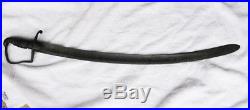

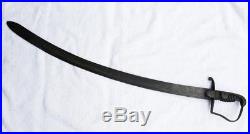


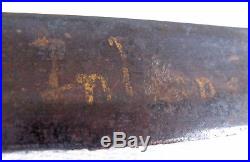
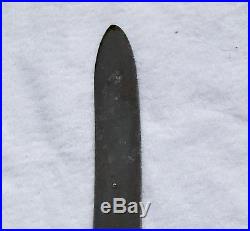
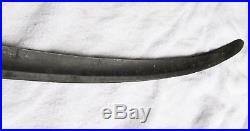


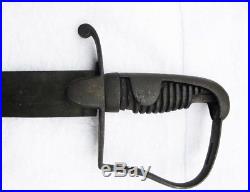
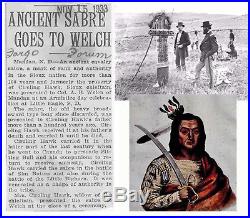

It has recently come to my attention thanks to a fellow. E-bayer : George Custer’s Last Message which is on display in West Point was obtained from a New jersey Collector in the 1930s. I find this information interesting as this sword must have been owned by a New Jersey collector also. As such I will donate some of the proceeds to The National Park Service ie: “The People” people like you and me, George Custer and Native Americans alike “We The People” who make up this great nation! Thank You for your help! 1876 liberty was barely 100 years old and growing up as fast as the cast Iron wheels of the steam engine could take her. Gone like yesterdays sunset was the misery and death of her children who dressed in blue and gray murdered one another as brother fought brother. No nothing would stop her now and the victorious President Grant would lead her west where there were gold and riches untold for the taking. The only thing that stood between liberty and her dreams were those bow bending savages. A perfect egg yolk yellow sun began to rise sluggardly along the horizon and its heat gently burned off the early morning fog, creating a halo among a few sleepy slow-moving clouds in a perfect blue sky. All this beauty just above a dusty patch of ground with foot high grasses transitioning from green to the color of hay and rippling together in unison an ocean swaying in the gentle morning breeze as Sunday, June 25, 1876, awoke. Sunday, June 25, 1876; a date that will never be forgotten, the day when the Army of The United States intended to capture the brave Lakota, Cheyenne and Arapaho Warriors. On that day one of these warriors dropped this sword. Many prominent archeologists, sword experts and even forensic investigators worldwide have contributed and helped me, I have included their remarks. I gladly accept any intelligent opinions or perspective on this battlefield relic. Cavalry did not carry any swords at L. (possibly two “may” have been on the battlefield). It is my contention that the Indian Yellow Nose may have owned this sword. If you go to National Park Service Little Bighorn Battlefield National Monument, you will find another sword that was discovered in 1918. Credit: Courtesy of the National Park Service, Little Bighorn Battlefield National Monument. LIBI_00822_01251, broken blade, grips missing, very badly rusted. Because swords and sabres were not used in field at this time it is not an army relic of the fight. Please read Excerpt from Yellow Nose account of Battle L. I have been collecting and purchasing swords since the mid-1980s. It is the love of these weapons that has taken me weekend after weekend to flea markets, antique shops, basements and anywhere I can find a vintage sword. One Saturday morning a few years back took me to a flea market in central New Jersey. A new vendor had set up shop and had 2 swords on his table. One was a War of 1812 Eagle head officers sword; the other a relic that I believed at the time to be a Prussian Blucher model 1811. To my surprise the following inscription in gold began to appear: Found at Georg- Custers Slaughter By The Indians Originally I had thought the inscription read: Found at Gen Custers Slaughter By The Indians But with more examination, I “believe” it may read: Found at Georg- Custers Slaughter By The Indians This inscription appears to be in style, dialect, substance and a script period to mid 19th century. I continue to go back every week and have never seen this vendor again. Which sucks but is the nature of an outdoor market I called a friend who is also knowledgeable on swords explained my find and we both belly laughed out loud and immediately dismissed this claim. This sword is a Prussian Blucher 1811 and these are ALWAYS U. Veteran pick-ups from WW1 and WW2. I sent pictures to some experts and everyone agreed it was most probably a Prussian 1811 based on length and tip. So my friend and I had a good laugh and I put this sword away. This sword continued to nag at me in the back of my mind. If you are a collector and you know an object has a story that has not been told to your satisfaction, that object resonates in your subconscious brain and pulls you back to it. This sword pulled me back to it! I proceeded to go over this sword (painstakingly) centimeter by centimeter with 25x magnification and then it appeared on the spine not legible to the naked eye. More research and the realization that his was not a Prussian sword but an English Model 1796 light Cavalry sword. This sword had been cut and rounded at the tip. So I think, ok cool, but this still makes it an antique during the Indian Wars and puts it over 4,000 miles away from the plains of Montana. They became a type of status symbol, particularly amongst some of the plains tribes. It starts to appear to me that the story of this sword being picked-up on a Montana battlefield is not as funny as I had originally thought. The tedious research has begun and the more knowledge I acquire about the little Big Horn the more I genuinely believe it is quite possible this sword was Found at Georg- Custers Slaughter By The Indians. Many respected professionals have shared their knowledge on this subject, which supports my belief in the inscription. This sword has been exposed to the elements on the right side no more than a few years. I base that on my experience with swords, some 33 odd years, with the emphasize on odd. SWORD: 1796 English light Cavalry sword. (Stampted On Spine) Length blade 30.5 shortened, spear point removed, improper sharpening (Indicative of Native American ownership as per an renowned expert) Sword hallmarks: Josh H. Reddel & Co (spine) Small English crown (right side fuller hardly visible through rust, visible only with 25x magnification only) Troop markings F over 13 Inscription in gold almost completely faded: Found at Gen Custers Slaughter By The Indians I particularly like the verbiage Found at Georg- Custers Slaughter By The Indians , we really do not use the word slaughter in modern speech and I believe it adds to the provenience of this sword. I also like the script used as it appears to be period also. Excerpt from Yellow Nose account: The appearance of this man was so striking and gallant that Yellow Nose decided that to kill him would be a feat of more than ordinary prowess. Yellow Nose was armed only with an old cavalry saber, having lost his gun. This saber had belonged to a boyhood friend, a Shoshone, at whose death his mother had given the saber to Yellow Nose. The battle had gone against the soldiers so heavily at this point that the officer stood finally alone. With saber drawn, Yellow Nose rode headlong at his enemy, prepared to cut him down at a stroke. Courtesy of misanthropus Some quotes from some of the top experts on Little Big Horn and the model 1796 I applaud your caution, but in this case I think you really may be on to something. First there is the fact that, as you have determined, huge numbers of old 1796s were commonly available in the Old West. One might also just reinforce the point with the observation that the 1796 is arguably the most successful sword in history, both in terms of its excellent design and graceful form, but also its ubiquity. It is still easy to get one- they are great swords and not very expensive, even today. I find it perfectly plausible that your sword belonged to a Sioux warrior or leader. In my experience, when swords come with fantastic stories attached to them, they are, most often, obviously untrue- clearly, the date, context and identity of the sword easily rules out the romantic associations attached to it. But when everything about the sword is consistent with the story that has formed around it. This makes me sit up and pay attention. When object and story agree, it can be an indication that the story is true. The balance of probability seems therefore to be in the favour of the idea that this sword was indeed in Indian hands. The fact that the blade has been altered (incorrectly) is also evocative of this scenario. After the CW many GAR halls and lodges painted their enemy trophies and weapons gold. I became very interested in the topic as I obtained the Sabre in the picture above that was plowed up in a field in the early 1900s in northwest Kansas by a homesteader. It is not well documented in regard to whether they used swords in battle. The swords that were acquired by Native men were often decorated with beaded leather and fur/feather trailers. Particularly after you had identified the sword type and maker of the sword, Josh H. Is a second l visible, at all? I presume you already are aware that this swordcutler company is noted as having been active in Careys Court, Birmingham (UK), between 1816-21. Joshua H Redell & Co, was a noted supplier of swords to the British Government. The mark you describe as F 13 Small English crown, which would appear to be the Viewers Mark, would perhaps make more sense if it was read Crown over B over 13 as the letter refers to the place of manufacture (the number refers to the viewer). Do you think the F is all you can read of a possible B? As to its being found on the site of an Indian Wars battlefield this is not at all impossible; as you have noted various swords were exported around the world and no doubt one may have ended up in North America. The fact that this sword was reputedly found in Montana, and bears indications that associate it with the site of the Custer battle, obviously takes the story of this sword to a possibly different level. The story is not, in itself, intrinsically impossible Anyway you are taking quite the right approach; cautious further research may prove the story of this, potentially, fascinating sword. It was common, as you say, for swords to be carried by others long after leaving the hands of the British. No white person or persons shall be permitted to settle upon or occupy any portion of the same; or without the consent of the Indians first had and obtained, to pass through the same. The item “GEORGE A. CUSTER LITTLE BIG HORN RELIC, 7th Cavalry LAKOTA SIOUX” is in sale since Thursday, June 2, 2016. This item is in the category “Collectibles\Militaria\1784-1860\Original Period Items”. The seller is “wblastoffwrr” and is located in Parlin, New Jersey. This item can be shipped worldwide.
